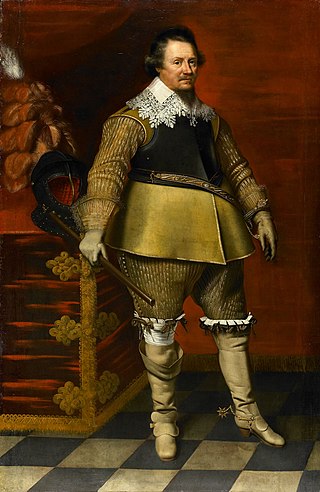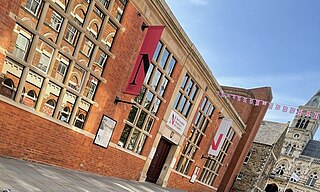Related Research Articles

A shoe is an item of footwear intended to protect and comfort the human foot. Though the human foot can adapt to varied terrains and climate conditions, it is vulnerable, and shoes provide protection. Form was originally tied to function, but over time, shoes also became fashion items. Some shoes are worn as safety equipment, such as steel-toe boots, which are required footwear at industrial worksites.

Footwear refers to garments worn on the feet, which typically serve the purpose of protection against adversities of the environment such as wear from rough ground; stability on slippery ground; and temperature.

A cordwainer is a shoemaker who makes new shoes from new leather. The cordwainer's trade can be contrasted with the cobbler's trade, according to a tradition in Britain that restricted cobblers to repairing shoes. This usage distinction is not universally observed, as the word cobbler is widely used for tradespersons who make or repair shoes.

A last is a mechanical form shaped like a human foot. It is used by shoemakers and cordwainers in the manufacture and repair of shoes. Lasts come in many styles and sizes, depending on the exact job they are designed for. Common variations include simple one-size lasts used for repairing soles and heels, custom-purpose mechanized lasts used in modern mass production, and custom-made lasts used in the making of bespoke footwear. Lasts are made of firm materials—hardwoods, cast iron, and high-density plastics—to withstand contact with wetted leather and the strong forces involved in reshaping it. Since the early 19th century, lasts typically come in pairs to match the separate shapes of the right and left feet. The development of an automated lasting machine by the Surinamese-American Jan Ernst Matzeliger in the 1880s was a major development in shoe production, immediately improving quality, halving prices, and eliminating the previous putting-out systems surrounding shoemaking centers.

The Bata Shoe Museum (BSM) is a museum of footwear and calceology in Toronto, Ontario, Canada. The museum's building is situated near the northwest of the University of Toronto's St. George campus, in downtown Toronto. The 3,665-square-metre (39,450 sq ft) museum building was designed by Moriyama & Teshima Architects, with Raymond Moriyama as the lead architect.
Clarks, the trade name of C. & J. Clark International Limited, is a British international shoe manufacturer and retailer majority owned by Viva Goods, Hong Kong. It was founded in 1825 by Cyrus Clark in the village of Street, Somerset, England, where the company's headquarters remain. The company has 1,400 branded stores and franchises around the world and also sells through third-party distribution. Clarks also operated concessions in Mothercare stores. Clarks had been owned by the Clark family and employees, but taken over via a £100 million investment by the Hong Kong-based private equity firm LionRock Capital, after which the Clarks family lost overall control of the company. In January 2021, Viva China Holdings agreed to acquire 51% of LionRock Capital, so has a substantial stake in the Clarks brand. Viva China was later renamed to be Viva Goods Co. Ltd.

Poulaines, also known by other names, were a style of unisex footwear with extremely long toes that were fashionable in Europe at various times in the Middle Ages. The poulaine proper was a shoe or boot of soft material whose elongated toe frequently required filling to maintain its shape. The chief vogue for poulaines spread across Europe from medieval Poland in the mid-14th century and spread across Europe, reaching upper-class England with the 1382 marriage of Richard II to Anne of Bohemia and remaining popular through most of the 15th century. Sturdier forms were used as overshoes and the sabatons of the era's armor were often done in poulaine style. Poulaines were periodically condemned by Christian writers of the time as demonic or vain. Kings of the era variously taxed them as luxuries, restricted their use to the nobility, or outright banned them. After becoming more common as women's footwear and expanding to awkward lengths, poulaines fell from fashion in the 1480s and were seldom revived, although they are considered an influence on some later trends such as the 1950s British winklepicker boots.

The Bytown Museum is a museum in Ottawa located in the Colonel By Valley at the Ottawa Locks of the Rideau Canal at the Ottawa River, just below Parliament Hill. Housed in the Commissariat Building, Ottawa's oldest remaining stone building, the museum provides a comprehensive overview of the origins of Bytown and its development and growth into the present city of Ottawa.

Church & Co Limited, branded Church's, is a luxury footwear manufacturer that was founded in 1873 by Thomas Church in Northampton, England. In 1999 the company was bought by Italian luxury fashion house Prada.

Go-go boots are a low-heeled style of women's fashion boot first introduced in the mid-1960s. The original go-go boots, as defined by André Courrèges in 1964, were white, low-heeled, and mid-calf in height, a specific style which is sometimes called the Courrèges boot. Since then, the term go-go boot has come to include the knee-high, square-toed boots with block heels that were very popular in the 1960s and 1970s; as well as a number of variations including kitten heeled versions and colours other than white.
Beatrix Ong MBE is a London-based British luxury fashion accessories designer, known for her 'classic with a twist' shoes.

The Shoe Museum in Street, Somerset, England exhibited shoes dating from the Roman era to the present day. The museum closed on 27 September 2019.
Calceology is the study of footwear, especially historical footwear whether as archaeology, shoe fashion history, or otherwise. It is not yet formally recognized as a field of research. Calceology comprises the examination, registration, research and conservation of leather shoe fragments. A wider definition includes the general study of the ancient footwear, its social and cultural history, technical aspects of pre-industrial shoemaking and associated leather trades, as well as reconstruction of archaeological footwear.

A fashion boot is a boot worn for reasons of style or fashion. The term is usually applied to women's boots. Fashion boots come in a wide variety of styles, from ankle to thigh-length, and are used for casual, formal, and business attire. Although boots were a popular style of women's footwear in the 19th century, they were not recognized as a high fashion item until the 1960s. They became widely popular in the 1970s and have remained a staple of women's winter wardrobes since then.

The National Union of Boot and Shoe Operatives (NUBSO) was a trade union in the United Kingdom which existed between 1873 and 1971. It represented workers in the footwear industry.

Over-the-knee boots, OTK boots, are long boots that fully or partly cover the knee. Originally created as a man's riding boot in the 15th century, in the latter part of the 20th century, the style was redefined as a fashion boot for women. Over-the-knee boots are also used as a work boot in circumstances requiring additional protection for the legs.

Concealed shoes hidden in the fabric of a building have been discovered in many European countries, as well as in other parts of the world, since at least the early modern period. Independent researcher Brian Hoggard has observed that the locations in which these shoes are typically found – in chimneys, under floors, above ceilings, around doors and windows, in the roof – suggest that some may have been concealed as magical charms to protect the occupants of the building against evil influences such as demons, ghosts and witches. Others may have been intended to bestow fertility on a female member of the household, or been an offering to a household deity.

Northampton Museum and Art Gallery is a public museum in Northampton, England. The museum is owned and run by West Northamptonshire Council and houses one of the largest collection of shoes in the world, with over 15,000 pairs, which was designated by Arts Council England as being of local, national and international importance.

Wildsmith Shoes is a high-end English handmade footwear manufacturer, founded in London in 1847 by husband and wife team, Matthew and Rebecca Wildsmith. They based their business on making and repairing boots for the Household Cavalry.
The Costume Society is national membership organisation in the United Kingdom, formed in 1965 to promote the study and preservation of historic and contemporary dress. It publishes a scholarly journal, Costume, as well as one-off publications; and organises events and study days. It is a registered charity under English law.
References
- ↑ Scrivener, Leslie (22 June 2008). "Mystery of the shoe in the wall". Toronto Star . Retrieved 20 May 2024.
- ↑ Prickett, Katy (9 December 2017). "The shoes hidden in homes to ward off evil". BBC News . Retrieved 20 May 2024.
- ↑ Shawcross, Rebecca (March 2019). "Miss June Swann: An Appreciation". Costume. 53 (1): 3–10. doi:10.3366/cost.2019.0091. S2CID 192489020.
- ↑ Weideger, Paula (24 August 1992). "You are what you wear on your feet: For June Swann, a boot is a clue to personality as well as social history. Paula Weideger talked to her". The Independent. Archived from the original on 2 April 2015. Retrieved 2 February 2015. ()
- 1 2 Newman, Cathy (September 2006). "The Joy of Shoes: Man's Shoe". National Geographic . Archived from the original on 18 August 2014. Retrieved 2 February 2015. ()
- ↑ London Gazette, 12 June 1976
- ↑ "Our history". The Costume Society. Retrieved 21 July 2019.
- ↑ Louise Mitchell and Lindie Ward, Stepping Out: Three Centuries of Shoes (Ashgate, 2008), p. 12.
- ↑ Cordwainers College Historic Shoe Collection, VADS.ac.uk